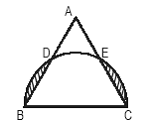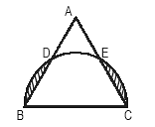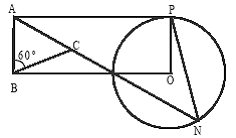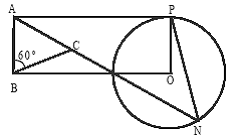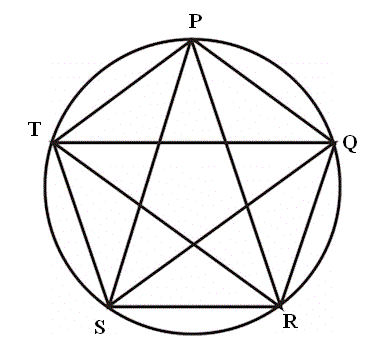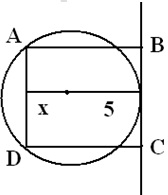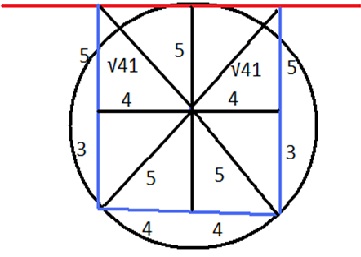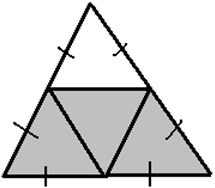Exams > Cat > Quantitaitve Aptitude
GEOMETRY SET II MCQs
:
B
Use Eulers triangle theorem which states that the distance,d between the incentre and circumcentre of a trinagle is given by d2 = R(R-2r) where R = circum radius, r= inradius
d2 = R(R-2r) = 6(6 - 2 x 2) = 12
d=2√3
:
B
Option (b)
O is the centre of the circle and the mid-point of BC. DO is parallel to AC. So, ∠DOB = 60°
Area of Δ BDO =34 * 49
Area of sector OBD = 496
Hence area of the shaded region
= 2[496 – 34*49]
= 49[13 – 32]
Shortcut
By graphical division, there are 3 equilateral triangles of areas of √34 * 49
Area of interest = (area of semi circle [r22] - area of three triangles) = (49*12 - 3*3*494)*(23) = 49*(13 – 32)
Four identical circles are drawn taking the vertices of a square as centers. The circles are tangential to one another. Another circle is drawn so that it is tangential to all the circles and lies within the square. Find the ratio of the sum of the areas of the four circles lying within the square to that of the smaller circle?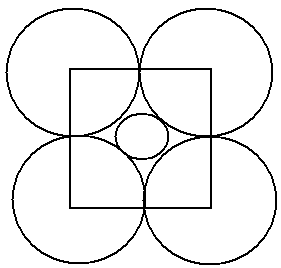
:
C
Let the radius of the identical circles be r. Hence, Areas of the four circles lying within the square = 4 x π x r24 = π x r2
Radius of the smaller circle = (diagonal of square−2r)2 = (2√2r−2r)2 = r (√2-1)
Required ratio = πxr2πx[x2(√2−1)2] = 1(√2−1)2
Shortcut : Lateral Thinking
The question is basically the ratio areas of larger to smaller circle because sum of areas within the square of the 4 circles add up to a full large circle.
Approximately compare the radii of small and large circles; the ratio is nearly 3.5/1, square of which is approx. 6/1. Only option c) works. This is a good approach which can be used for a lot of geometry questions.
:
B
AB = BC and ∠ABC=60°. Therefore, ΔABC is an equilateral triangle
Now see that ABOP is a rectangle.
And ∠BAN=60°, Therefore, ∠NAP=90∘ − 60∘ = 30∘
And ∠ANP =12 * 90 = 45∘
Now in ΔANP,
∠NPA=180∘−45∘−30∘=105∘
And hence ∠NPO = ∠NPA - ∠OPA = 105∘ - 90∘ = 15∘
Shortcut
ABC is an equilateral triangle and ABM is a 30 – 60 -90 triangle (M being the point of intersection of AN and the circle). OMN is also 30∘. MOP = 90∘, and MNP = 45∘; MPO = PMO = 45∘. NPO = 180∘ – 75∘ – 45∘ – 45∘ = 15∘
:
Interior angle = [(2n-4)x90]/n = 108
2x= 360-(108x2) = 144
angle P = 180-144= 36
Total = 36x5= 180
Useful to remember: Sum of angles in a star= 180∘
Shortcut: Clearly the star point trisects the angle in a pentagon. Hence each angle = 108/3 = 36.
Sum of angles = 36*5 = 180
Alternatively: Sum of angles of a n point star = (n – 4) x 180∘ , where n = number of sides of a polygon.
Here, n = 5. Sum of angles of a n point star = (5 – 4) x 180∘ = 180∘.
:
A
Area of the square: (x + 5)2
So the answer has to be a perfect square: 36 or 64
If area is 36 then x = 1; so EF = 6, OE = 1, OA = 5 and EA = 4
Angle OFB = ABF = BAE = 90, so angle OEA = 90
OE, EA and OA do not form Pythagoras triplet.
If area is 64 then x = 3, EF = 8, EA = 4, OA = 5
Shortcut 1
Reverse Gear approach-With a radius of 5, we will get a square of side 5%undefined2. area will be 50, but we know the side has to be slightly greater than 5%undefined2. hence, choose an option which is slightly greater than 50; i.e. 64
Shortcut 2
Graphical division:- The square gets divided into 8 parts. 4 parts are each right angled triangles of sides 3,4,5 and hence with area 6. 4 of them in total have an area of 24. The other 4 are triangles of the form 4, 5, √41 and whose areas are 10 each. Total area = (6+10)*4 = 64.
Concentric circles are drawn with radii 1, 2, 3 … 100. The interior of the smallest circle is colored black and the annular regions are colored alternately red and black, so that no two adjacent regions are the same color. The total area of the red regions divided by the area of the largest circle is
:
C
Areas of circles follow the sequence 1,4,9,16,…………1002
Areas of Black & Red annuals – 1,3,5,7,9……………199 – General term 2n – 1
Red annuals – 3, 7, 11, …………….. 199 Sum = (502)*(3 + 199)
Largest circle’s area = 1002
Ratio = 101200
Note : Ignore pi as it is a ratio of areas
Shortcut: Reverse gear approach –
We know that the denominator is 1002 and num is an integer, hence the denominator cannot be 101 as it is in no-way a factor of 10000. Hence option d) has been eliminated.
We need to find R(R+B). R + B = 10000. Each of the red annual is greater in area by 2 units than the subsequent black annual and there are 50 such cases. Hence R = 5050 and B = 4950. R(R+B). = 505010000 = 101200
:
C
Deducing a Pattern:
Taking two circles. The number of points of intersection is 2 at most.
If u consider 3 circles, the number of points of intersection = 6 ( the third circles will have 4 points of intersection with the other 2 circles and those two circles will have 2 points together).
Shortcut:- Assumption & Reverse Gear:
Taking two circles. The number of points of intersection is 2 at most. From this itself, option a, b and d can be eliminated giving answer c.
:
B
Sum of the interior angles of a polygon = (n-2) 180
n2 * (2a+ (n-1)d)= (n-2)180
n2 * [2*(120) + (n-1)5]=(n-2)180
n[48+(n-1)] = (n-2)72
n2 -25n + 144=0
n=9 and n=16
when n= 16, the greatest angle will be equal to a+15d = 120 + 15 x 5 = 195 and no interior angle of a
polygon can be equal to or greater than 180. hence answer =b

